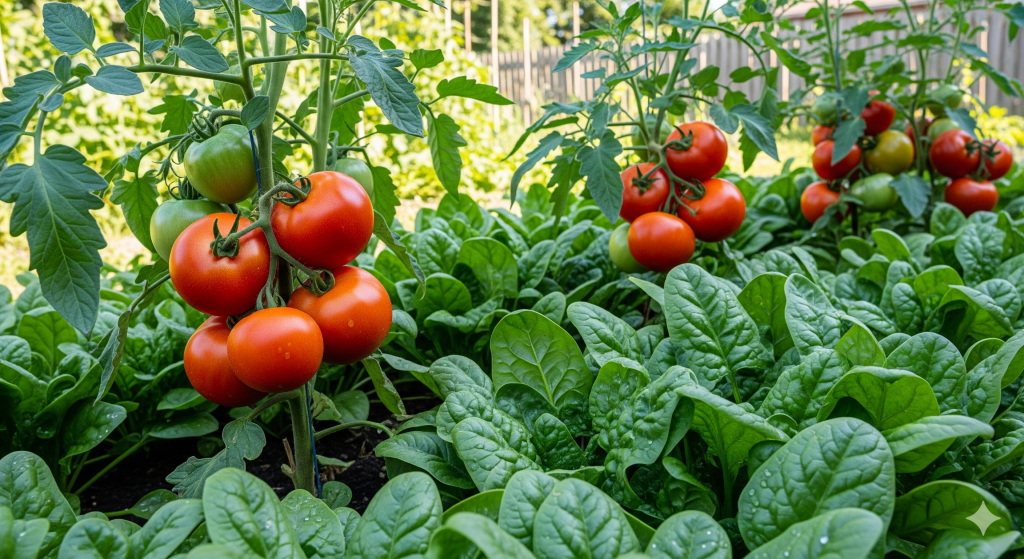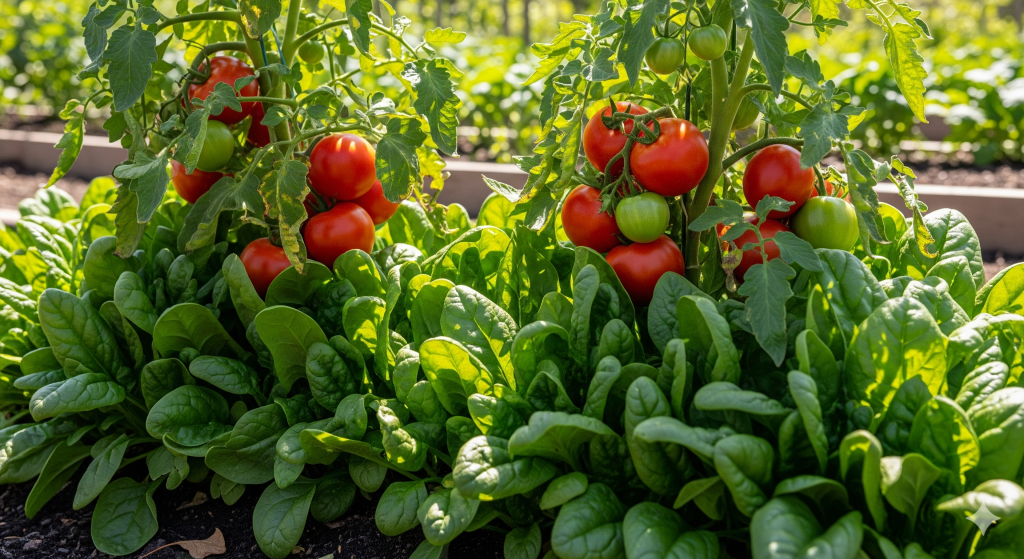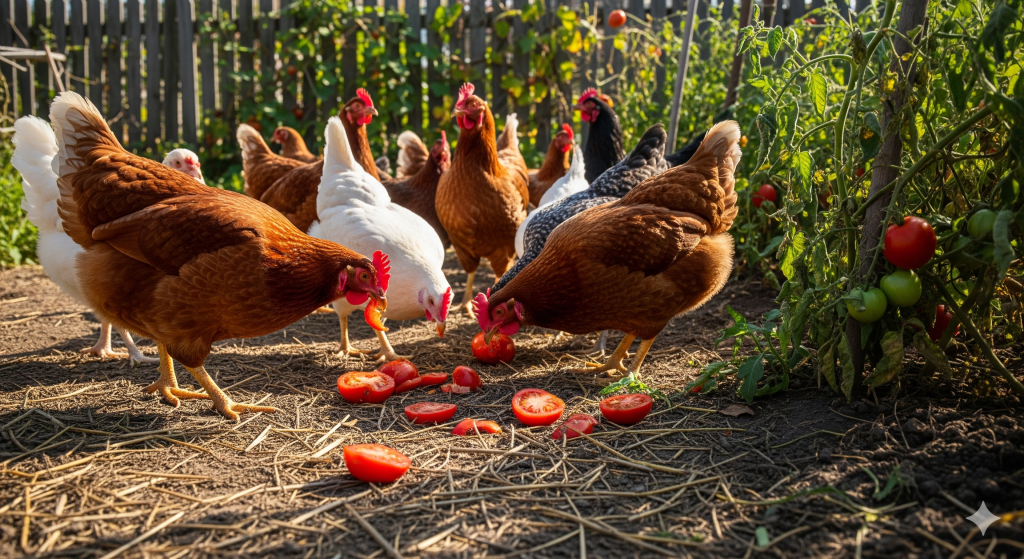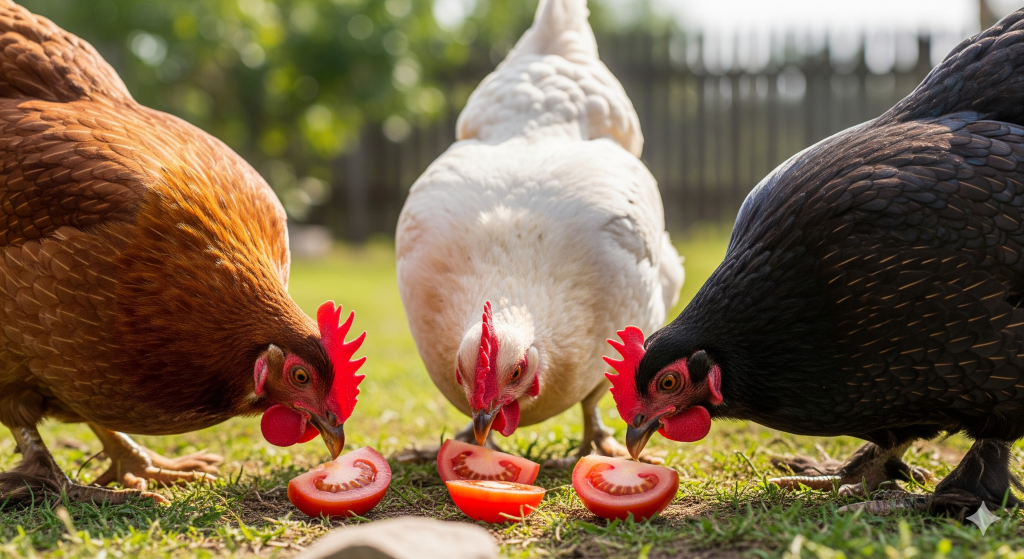Table of Contents
In the art of companion planting, gardeners are always seeking clever combinations that create a healthier, more productive, and space-efficient garden. One of the most practical and beneficial pairings, especially for those looking to maximize their harvest, is spinach and tomatoes. This leads to the popular question: “Can I plant spinach and tomatoes together?” The answer is a resounding yes!
This isn’t just a convenient pairing; it’s a strategic one that leverages the different growth habits and seasonal preferences of each plant. By planting these two together, you can create a symbiotic relationship where the spinach acts as a living mulch for the tomato, and the tomato, in turn, provides life-extending shade for the spinach. This intelligent use of space and resources is a hallmark of a well-planned and highly efficient garden.
This in-depth guide will explore the many benefits of this classic partnership, provide practical instructions for planting them together in both garden beds and pots, and highlight other companions that work well (and which to avoid) with these versatile plants.
Can I Plant Spinach with Tomatoes in Pots?
Yes, planting spinach and tomatoes together in pots is an excellent strategy, particularly for gardeners with limited space on a patio, balcony, or in a small yard. This “two-for-one” approach in a single container is a highly efficient way to get a double harvest from the same square footage.
Success with this container combination hinges on a few crucial factors:
- Pot Size is Everything: This is the most critical element. Both plants need ample room for their roots to thrive. Choose a large container, at least 10-15 gallons (or roughly 18-24 inches in diameter), to comfortably house a single tomato plant and several spinach plants around its base. Excellent drainage holes at the bottom of the pot are non-negotiable to prevent waterlogging.
- Use High-Quality Potting Mix: Never use soil from your garden in pots. It is too dense, will compact easily, and will not drain properly, leading to root rot. Fill your container with a high-quality, well-draining potting mix that is rich in organic matter like compost.
- Strategic Planting and Timing: Plant your tomato seedling in the center of the pot. Then, sow spinach seeds or plant spinach seedlings around the perimeter, about 4-6 inches away from the tomato stem. The spinach will grow quickly in the cool spring weather, and you can often get a full harvest from it before the tomato plant reaches its mature size and begins to demand the full volume of the pot.
- Consistent Watering and Feeding: Plants in containers dry out much faster than those in the ground. You will need to check the soil moisture daily, especially on hot days, and water thoroughly whenever the top inch or two of soil feels dry. Because both plants are feeders and frequent watering leaches nutrients, plan to feed your potted duo with a balanced liquid fertilizer every 2-3 weeks during the peak growing season.
Ready to Take Your Self-Sufficiency to the Next Level?

If you love the self-sufficient lifestyle, this is the only guide you’ll ever need. Learn how to generate your own power, secure your water supply, and become truly independent. No fluff, just actionable plans.
➡️ Check out The Self-Sufficient Backyard and start your journey today!
Benefits of Planting Spinach with Tomatoes
The partnership between spinach and tomatoes is a perfect example of succession planting and efficient use of space, where each plant provides something the other needs.
- Living Mulch: As the spinach grows, its dense leaves form a lush, green carpet over the soil. This living mulch provides several key benefits for the tomato plant. It shades the soil, keeping the roots cool during the heat of summer. This is particularly important for maintaining consistent soil moisture and preventing the soil from drying out too quickly.
- Weed Suppression: The canopy of spinach leaves effectively blocks sunlight from reaching the soil, which naturally and effectively suppresses the germination and growth of weeds. This means less competition for your hungry tomato plant and less time spent on the tedious task of weeding.
- Extended Spinach Harvest: Spinach is a cool-season crop that typically “bolts” (goes to seed and becomes bitter) when the weather gets hot. When planted at the base of a growing tomato plant, the shade cast by the taller tomato can significantly cool the soil and the spinach leaves. This can delay bolting by several weeks, allowing you to continue harvesting fresh spinach long into the warmer months.
- Efficient Use of Space (Intercropping): This is a classic example of intercropping. The fast-growing spinach can be planted and harvested early in the season while the slow-growing tomato plant is still establishing itself. By the time the tomato plant needs the full space to spread its roots and foliage, the spinach has already been harvested, meaning you get two crops from the same garden real estate.

What Not to Pair with Spinach?
While spinach is a friendly and beneficial companion to many garden plants, there are a few it is best to keep at a distance.
- Potatoes: Potatoes and spinach are not a good match. Potatoes are heavy feeders and can aggressively compete for the same nutrients in the soil. More importantly, they can attract pests like flea beetles, which can also cause significant damage to spinach leaves.
- Fennel: This is a well-known “antagonistic” plant in the gardening world. Fennel releases a chemical substance from its roots that can inhibit the growth of many other plants, including spinach. It’s always best to give fennel its own dedicated spot, far away from your main vegetable beds.
- Corn: Corn grows very tall and creates a dense canopy of shade. While a little afternoon shade is good for spinach, the deep shade cast by a block of corn will prevent spinach from getting the sunlight it needs to thrive.
- Plants in the Same Family (in succession): While they grow fine together, avoid planting spinach in a spot where you have just grown its close relatives, Swiss chard or beets. This can encourage the buildup of shared pests and diseases, such as leaf miners.
Conclusion
The combination of spinach and tomatoes is a brilliant and highly effective companion planting strategy that every gardener should try. It’s a partnership that exemplifies the principles of smart garden design—maximizing space, improving soil health, and creating a more resilient ecosystem. By planting fast-growing spinach as a living mulch at the base of your slow-growing tomato plants, you can enjoy an early harvest of leafy greens while simultaneously protecting and nurturing your main tomato crop.
This dynamic duo works in harmony, with the spinach keeping the soil cool and weed-free, and the tomato providing life-extending shade in return. Whether you are working with a large in-ground garden, a raised bed, or a simple container on your patio, this pairing is a simple, intelligent, and productive way to get the most out of your garden space, proving that a little bit of planning can lead to a doubly delicious harvest.



